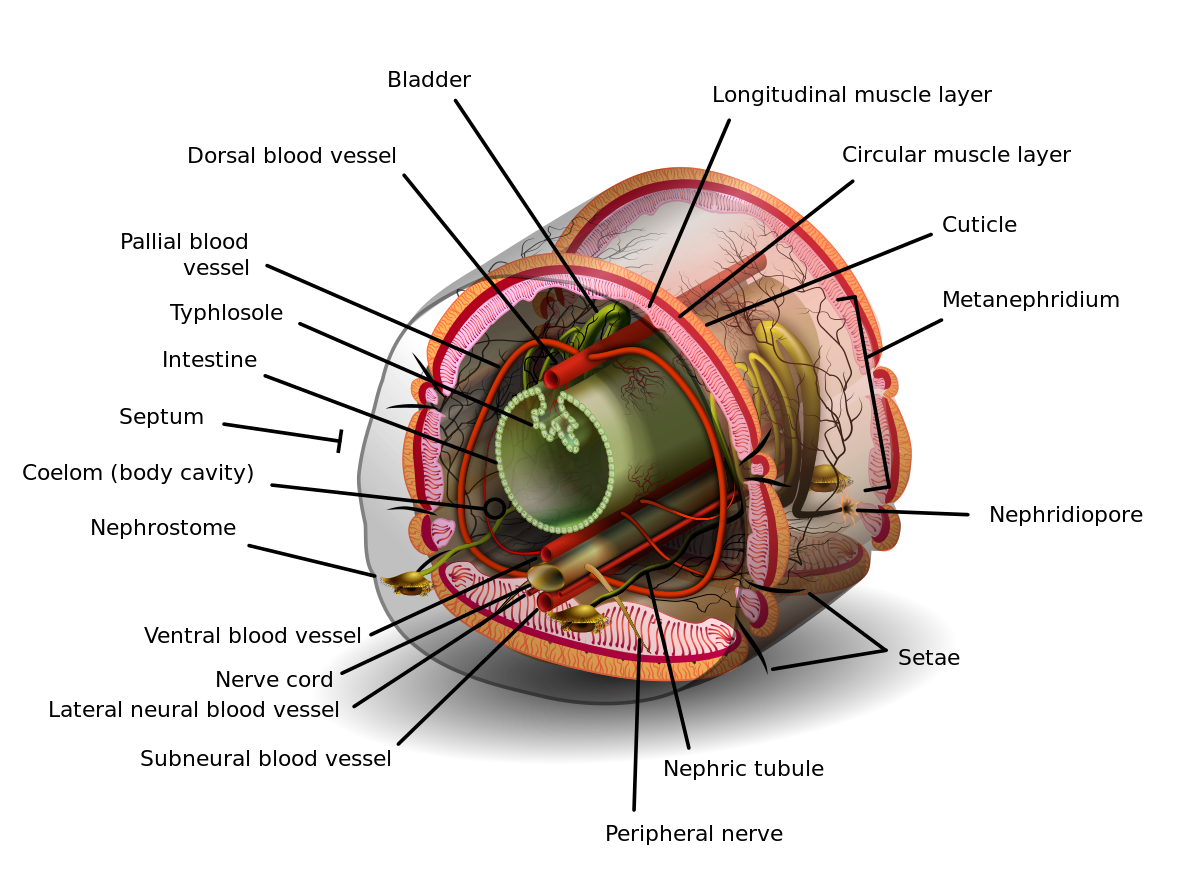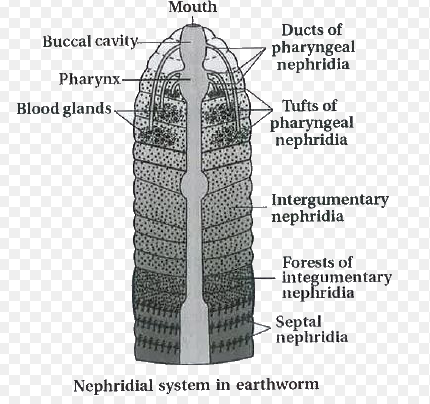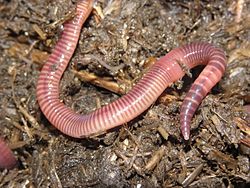Nephridia in Earthworm – Structure, Types, and Functions
Earthworm nephridia are segmentally arranged excretory tubules that perform functions analogous to vertebrate kidneys, crucial for waste removal and osmoregulation. Each nephridium consists of a ciliated funnel (nephrostome), convoluted nephridial tubule, and an external opening (nephridiopore).

1. Overview & Classification
Earthworms possess three distinct types of nephridia:
- Septal nephridia (enteronephric): Located near septa (especially beyond the 15th segment), discharging waste into the intestine via supra‑intestinal ducts.
- Integumentary nephridia (exonephric): Embedded in the body wall (from segment 7 onward), these open directly through the body wall via nephridiopores.
- Pharyngeal nephridia: Found in segments 4 through 6; they discharge into the buccal cavity or pharynx.
2. Anatomical Structure
2.1 Septal Nephridia
Each consists of :
- Nephrostome: A ciliated funnel that draws coelomic fluid into the tubule.

- Nephridial Body: Features a long coiled loop with a straight lobe. The loop comprises a proximal and distal limb twisted spirally (9–13 turns).
- Terminal Duct: Joins the loop to the septal excretory canal, conveying wastes into the intestine.

2.2 Integumentary Nephridia
Small, V‑shaped nephridia without nephrostomes; their lumen contains two ciliated canals, and they open externally via nephridiopores.
2.3 Pharyngeal Nephridia
Similarly structured to septal nephridia (without nephrostome) but unite into ductules that open inside the buccal cavity or pharynx.
3. Physiological Role
- Excretion: Waste is filtered from coelomic fluid into nephrostomes, passes through tubules where valuable ions/water may be reabsorbed, and is then excreted either into the gut (enteronephric) or outside via pores (exonephric).
- Nitrogenous Waste Forms: Earthworms excrete a mixture—approximately 72% ammonia (NH₃), 5% urea, the remainder as other compounds like amino acids; proportions vary with feeding status.
- Osmoregulation: Nephridia aid in maintaining water and ion balance by selective reabsorption in drier vs. wetter seasons.
4. Comparative Context & Evolution
Nephridia in annelids are classic metanephridia, more advanced than protonephridia (flame cells) found in simpler phyla like Platyhelminthes. They reflect a transitional evolutionary strategy combining filtration, reabsorption, and controlled excretion.
Additionally, symbiotic bacteria like Verminephrobacter inhabit earthworm nephridia, a unique mutualism with vertical transmission from parent to embryo.
5. Key Technical Summary Table
| Nephridium Type | Location | Output Destination | Structure Highlights |
|---|---|---|---|
| Septal (Enteronephric) | Septa after segment 15 | Intestine | Nephrostome → coiled tubule → duct |
| Integumentary (Exonephric) | Body wall segments 7+ | External via pore | V-shaped tubule without nephrostome |
| Pharyngeal | Segments 4–6 | Buccal cavity / pharynx | Tubule without nephrostome |
Nephridia in earthworms exemplify sophisticated invertebrate excretory systems. They are highly specialized, exhibit distinct anatomical types, and play critical roles in excretion and internal regulation. This topic perfectly broadens Biozoomer’s coverage on annelid morphology and physiology.
6. Functional Elaboration of Nephridia in Earthworms
6.1 The Functional Significance of Nephridia
When discussing what are nephridia, they are essentially the chief excretory and osmoregulatory organs in annelids. In earthworms, the function of nephridia is twofold:
- Excretion : removal of nitrogenous wastes from coelomic fluid and blood.

- Osmoregulation : maintaining water and ion balance in varying soil environments.

This dual role explains what is the purpose of nephridia in annelids: not only detoxification, but also survival in both moist and drier soil niches.
6.2 Septal Nephridia of Earthworm
Among the types of nephridia in earthworm, the septal nephridia are the largest and most structurally complex. They lie intersegmentally on the septa and discharge through supra-intestinal canals into the alimentary tract. By channeling nitrogenous waste into the intestine, they help combine excretory and digestive functions, improving metabolic economy. The septal nephridia of earthworm also illustrate how internal excretion can serve as a precursor to vertebrate-like excretory integration.
6.3 Pharyngeal Nephridia of Earthworm
The pharyngeal nephridia of earthworm are confined to anterior segments and open into the buccal cavity or pharynx. Their strategic position ensures rapid removal of waste from the richly vascularized foregut region, protecting the worm’s feeding apparatus from toxic accumulation.
6.4 Nephridiopores in Earthworm
The integumentary nephridia open directly to the exterior via small external pores called nephridiopores in earthworm. These minute surface openings, distributed segmentally, are crucial for exonephric excretion. They not only serve waste removal but also contribute to regulating cutaneous moisture, reinforcing the importance of nephridia in osmoregulation.
7. Nephridia Structure in Greater Detail
The nephridia structure is finely adapted for filtration, reabsorption, and secretion. Each nephridium earthworm contains:
- Ciliated nephrostome : gateway for coelomic fluid.
- Tubule system : a proximal ciliated region, a middle loop (with selective resorption), and a terminal duct.
- Nephridiopore : the external or enteric opening.
When illustrated as a nephridia diagram, this microanatomical complexity highlights its analogy to vertebrate kidneys: nephrostome parallels Bowman’s capsule, tubules resemble renal tubules, and nephridiopores mimic urethral outlets.
8. Excretory Products and Nitrogen Metabolism
The function of nephridia in earthworm is also evident in the forms of nitrogenous waste. Depending on hydration and diet, earthworms shift between ammonotelism and ureotelism. Earthworms’ excretion is mostly ammonia, but urea and amino acids are also expelled. This physiological flexibility demonstrates why nephridia help in excretion and osmoregulation in fluctuating terrestrial conditions.
9. Earthworm Excretory System - Integration & Evolution
The earthworm excretory system is an elegant assembly of thousands of nephridia earthworm units, coordinated to maintain homeostasis. Unlike flame cells in flatworms, these metanephridia filter directly from the coelomic cavity.
From an evolutionary perspective, the nephridium represents a transition between primitive excretory systems and the sophisticated kidneys of higher animals. The presence of specialized forms (septal, integumentary, pharyngeal) underscores how segmentation allowed functional differentiation of the same organ system.
10. Visual Representation
A nephridia diagram typically shows :
- Location of septal nephridia on septa.
- Integumentary nephridia opening through body wall nephridiopores.
- Pharyngeal nephridia clustered around the buccal cavity.
Labeling these structures reinforces their nephridia function earthworm and allows learners to visualize how each type contributes to overall excretion.

